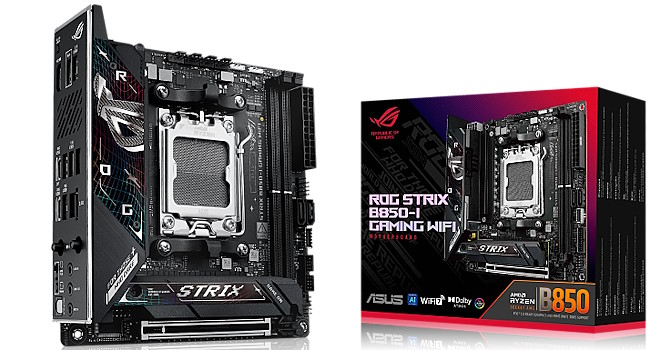The ASUS ROG Strix B850-I Gaming Wi-Fi is already well-regarded in small form factor circles and rightly so. It trumps the competition in a number of areas, looks good, is relatively flexible in terms of being able to handle air cooling, AIO liquid coolers or even custom liquid-cooled PCs, and as you’d expect at this price, doesn’t skimp on features. The only thing absent compared to X870-based boards is USB4, and perhaps better M.2 or VRM cooling and more elaborate power delivery. You otherwise get Wi-Fi 7, 2.5 Gbps Ethernet, PCIe Gen 5 SSD and GPU support, enhanced GPU release and plenty of high speed USB ports. Also worth mentioning are CMOS Clear, USB BIOS Flashback and the configurable FlexKey which is set to “reset” out of the box, besides a 2-pin thermistor header.
In terms of direct comparisons, we should first take a look at the ROG Strix X870-I Gaming Wi-Fi. It’s nearly $200 more expensive, but offers two USB4 ports and more USB overall, better VRM and M.2 cooling at least on paper, higher-rated power stages, and also has an external USB audio card with volume control, power and reset buttons and Type-C and Type-A 10 Gbps ports. Most of these are premium features that aren’t essential, and the larger M.2 and audio stack means even worse CPU cooler compatibility.
If $300 is your limit then you have a few other options to consider too. ASRock’s Phantom Gaming B850I Lightning Wi-Fi impressed us with its sub $220 price tag while maintaining a decent spec, with the only dropdowns being a less polished EFI, Wi-Fi 6E as opposed to Wi-Fi 7, and nothing faster than 10 Gbps when it comes to USB ports. It’s rear VRM heatsink may have helped to see it undercut the ASUS board in VRM temperature too, but it also has an extra Type-A USB port and matches the ASUS board in having a 2-pin thermistor header.
Gigabyte has two options below $300—the B850I Aorus Pro at around $260 and the X870I Aorus Pro Ice at around $285. Both benefit from tool-free M.2 ports and the latter has the advantage of USB4, but apart from a snazzy white design, it doesn’t offer any significant advantages, while the ASUS board has an extra fan header and thermistor header on top as well as a slightly better EFI.
Finally, we get to the MSI MPG B850I Edge Ti Wi-Fi, which is a substantial $50 cheaper than the ROG Strix B850-I Gaming Wi-Fi. Besides offering 5 Gbps Ethernet, it has two key advantages over the ASUS board, with the first being better VRM temperatures despite there being a VRM fan present in the ASUS board. The MSI board’s fan is only there for M.2 SSD and chipset cooling, and while MSI made a bit of a mess of things in the configuration, some simple tweaks saw it easily tame our PCIe Gen 5 SSD.
While it doesn’t suffer the same cooler compatibility as the ASUS board, It has even fewer USB ports, and lacks a thermistor header or any kind of enhanced GPU release—which is very useful in Mini-ITX systems. It makes up for these issues somewhat with extension cables for the front panel and the EZ Conn Connector, but its software also lacks a few of the features the ASUS board has when it comes to fan control.
Another review to wait for is MSI’s X870 Mini-ITX model that was revealed at Computex and is expected to land soon. If it’s anything like its B850 sister board and it doesn’t retail too far the wrong side of $300, it could well give the ROG Strix B850-I Gaming Wi-Fi some trouble.
Overall, the ROG Strix B850-I Gaming Wi-Fi fares well against the competition in a number of areas, but also falls short when it comes to VRM and M.2 SSD cooling, albeit only with PCIe Gen 5 SSDs. We were also using a Ryzen 9 9950X under sustained synthetic load, so the VRMs would be cooler with fewer cores or a lighter load, plus we didn’t experience any ill effects in terms of throttling despite temperatures being a bit above the comfort zone.
Apart from those VRM and M.2 temperatures and potential clearance issues with certain models of AIO liquid cooler, the ROG Strix B850-I Gaming Wi-Fi is seemingly the most flexible and well-rounded B850 option out there. However, it is certainly has viable competition—depending on your priorities—with the slightly leaner ASRock Phantom Gaming B850I Lightning Wi-Fi being much cheaper, and the MSI MPG B850I Edge Ti Wi-Fi offering better VRM and M.2 SSD temperatures.

